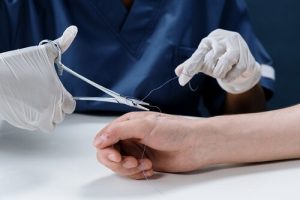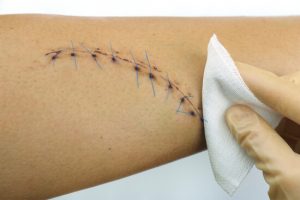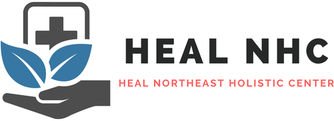Is Removing Stitches Really Necessary?
If it is your first time getting stitched, you might be wondering if removing stitches is necessary. The answer is a huge yes! Stitches need to be removed after 4 to 14 days depending on the wound area. Removing it too early can cause the wound to open again while leaving it on for too long will leave noticeable scars. If you want to know how to remove the sutures, ask your physician for the guidelines.
Purpose Of Stitches
First, let us find out the purpose of getting stitched. Little scratches can heal on their own. With the help of soap, water, and anti-infection products, minimal wounds last for few days only. However, deeper and severe cuts require stitches to avoid infection. The main purpose of sutures is to bind the tissues together to help them heal faster. Surgical procedures often require stitches in order to close the wound area and fuse back the skin together. After a few days, the removal of the stitches will follow.
When Do You Need Stitches
 It is not easy to tell if your cuts or wound would actually need sutures. Only your physician will be able to determine if stitches are required or not.
It is not easy to tell if your cuts or wound would actually need sutures. Only your physician will be able to determine if stitches are required or not.
The following cuts may need immediate medical attention;
- zigzagged and deep cuts
- the wound area is located in the face, neck, or body parts where scars would look unpleasant
- the cut is bleeding nonstop for at least 20 minutes
- numbness on the cuts
- the cut is located on body parts that need to function properly such as hands and limbs
If you think that your wound is included in these categories, visit your doctor promptly. Apply pressure on the wounded area right away to quickly stop the bleeding and prevent further infection. Minor wounds would only often require the use of adhesive strips.
Procedure
Initially, the nurse will put anesthesia or numbing cream on the cut, this will help you feel numb enough to not feel the pain of the needle. After a few minutes, the cleaning of the wounded skin will proceed. Sterile water will be used to thoroughly wash out dirt and germs.
If you are curious if this procedure will hurt, the answer is no. The anesthesia will immediately do its work to numb the area for stitches. Its main purpose is to remove the sensation of pain. Prior to the stitching, your physician will assure that there are no tiny objects left inside the wound.
The doctor will then proceed to stitch your cut by using a small needle to sew the skin back together. Your stitch will be checked accordingly to see if there are no loose ends and if everything is well done. Sometimes, adhesive strips are also placed on top of the wound after the removal of the stitches to secure the sutures and protect it from dirt.
Instruments Used For Stitching
In order to assure an infection-free suturing process, it is important to have complete stitching materials. Here are the few things that complete a suturing kit;
- Numbing cream. This is usually a gel-type material that is used to numb the wounded area. It works by temporarily blocking the pain signal that’s being sent to the brain.
- Sterile water. This is the only kind of water that is totally free of microorganisms such as bacteria, fungi, and spores. The main use of sterile water is to clean the wounded area and wash out dirt and small particles on the cut.
- Clean cloth. It is essential to use clean cloth in cleaning out cuts. Dirty materials could cause infection.

- Suture needle.
- This is used to hold the thread
- Scissors. Used to cut the excess thread.
- Suture thread. There are several types of suture threads. Some doctors even use threads that dissolve over time so the patient will not have to go back for the removal.
- Adhesive strips. When the cut or wound is not too deep, doctors go for adhesive strips instead of actual stitches. This material will seal the wound by pulling the skin back together. This is an effective way to prevent infection and further harm to the cut.
Note that all materials that will be used on suturing or any medical procedures need to be sterilized and cleaned before using. If you are going to do it yourself due to emergency reasons, make sure that you will use instruments that are at least boiled in water.
Stitches Aftercare
Stitches need to be taken care of to ensure a fast and free from the infection healing process. To guarantee the quick recovery of your wound, do the following guidelines;
- Keep the wound clean and cry. After the procedure, your physician will give you instructions on how to properly clean your sutures. Pat dry the stitches after cleaning. Keeping it moisture-free for 1 day after the procedure will help the wound to heal as quickly as possible. Avoid using creams or ointments that are not suggested by your doctor, moisture can slow down the healing process.
- Avoid swimming. Swimming or any other water activities will put your wound at risk of infection.
- Prevent doing activities that will put pressure on the wound. The sutures might break down if it’s forced which might lead to stitch damages.
- Let your wound heal on its own. Avoid touching the wound too frequently. Dirty hands may bring in germs and bacteria to the wound.
Removing Stitches
Some sutures fall off on their own and others fall off too early. If this incident happens, go see your doctor immediately. Dissolvable stitches don’t need to be removed, these are the kinds of materials that dissolve and leave no noticeable marks on the skin.
The specific day of removing stitches will depend on the location of the wound area. Below is the timeline for removing stitches according to its location:
- Face- 3 to 5 days.
- Trunk- 7 to 10 days
- Joints- 14 days
- Scalp- 7 to 10 days
- Limbs- 10 to 14 days
Before removing the sutures, the doctor will clean the skin and wound. Medical professionals use a suture or staple remover to pull out the sutures one by one. After removing all the stitches, the wound will be cleaned one more time before placing adhesive strips to cover the wound.

